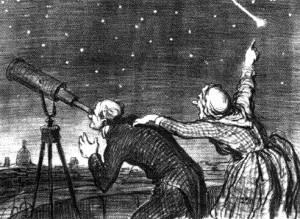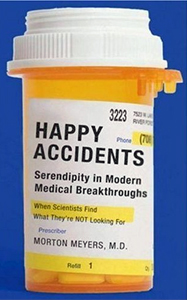Happy Accidents: Serendipity in Modern Medical Breakthroughs
What is creativity? What are the factors and circumstances that influence it? What circumstances provide the insight, the flash of illumination, the spark of intuition? What are the differences and similarities in creativity in science versus the arts? How have discoveries come about in science? In medicine?
Often, at least in the popular mind, the concept of creativity – ideas that are fundamentally novel with respect to the whole of human history – is automatically linked with the arts rather than with the sciences. Literature, plays, and movies depict the artist as obsessed and struggling with inchoate needs for self-expression. The scientist, on the other hand, is generally viewed as methodical and disciplined, in pursuit of a predetermined goal to which a certain methodology is adapted and applied.
Yet, there are marked similarities in the creative impulses that drive both the artist and the scientist. Common to both are the search for self-expression, for truth, and for order; an aesthetic appreciation of the universe; a view of reality; and a desire for others to see the world as one sees it.
In March, 2007, I published Happy Accidents: Serendipity in Modern Medical Breakthroughs (Arcade). The paperback was published in 2009 and re-issued in 2011 (Arcade, an imprint of Skyhorse). It has been translated into Chinese and Japanese editions.
The idea of serendipity means more than just a pleasant surprise. It indicates searching for one thing, but unpredictably, unexpectedly stumbling across another finding of what may prove to be of even greater benefit.

When the muse of serendipity taps you on your shoulder or whispers in your ear “Look at this, look at this”, it’s wise to listen.
In the discovery of every-day commercial products, society has readily accepted the contribution of chance findings. An example is that of a drug company seeking an antacid based on amino acids, the building blocks of a protein. When the researcher, having inadvertently spilled some of the crystals, wet his finger on his tongue to turn a page in his laboratory notebook, he was astonished at the taste of sweetness. In this way, the artificial sweetener know as Equal or NutraSweet was born. In another instance, an engineer developing radar sets found that a candy bar in his pocket had melted. With the realization that the unit’s power device was emitting radio waves, the microwave oven was born.
Yet, serendipity is the great secret in medical science. It is the thread that runs through the tapestry of modern medical discoveries.
Happy Accidents expands upon the themes of multiple presentations I have made over many years. These were initiated by my lead article entitled “Science, Creativity, and Serendipity” in the October 1995 AJR (American Journal of Roentgenology) issue celebrating the centennial of the discovery of the X-ray, based largely in part on personal interviews with innovative researchers who profited from chance observations.
Over the following years, this theme was further developed in an address to the South African Radiological Society, the Leo Rigler Memorial Lecture at the University of Minnesota, the Robert D. Moreton Lecture to the University of Texas, the Richard Schatzki Memorial Lecture at the Harvard-affiliated Mount Auburn Hospital, the Thomas Beneventano Memorial Lecture at the Montefiore Medical Center in the Bronx, the Diwan Aggarwal Memorial Oration to the 20th International Congress of Radiology in New Delhi, the Inauguration Lecture to the 15th European Congress of Radiology in Vienna in 2003, and the SGR Honorary Lecture at the 17th Annual Meeting of the European Society of Gastrointestinal and Abdominal Radiology in Crete in 2006. The latter was derived from the book’s concluding chapter and was directed as advice to young academically inclined physicians, emphasizing that meaningful curiosity-driven research is often accomplished by an individual, often young, often working alone with limited resources, who perseveres in the face of the conventional wisdom.
Every physician is certainly familiar with uncovering incidental findings in daily practice that may redirect the course of clinical investigation. The value of accidental discoveries is deeply rooted in diagnostic imaging. Indeed, it is the basis upon which the specialty was founded. The unexpected discovery of the X-ray in 1895 and of radioactivity the following year are well known to radiologists.
In my Preface, I recall the circumstances of a serendipitous observation that led to my formulation of the dynamics of spread of disease throughout the abdomen. This insight has been universally adopted and now serves as a basis of detection and management. This set me on a quest to understand the role of chance in scientific research and its contribution to medical advances in the past century. After detailed inquiries and personal interviews with a number of Nobel laureates and winners of other prestigious awards, I was amazed at the findings.
In any field, discovery is not only unpredictable but it requires serendipity. We invent by intention, but we discover by surprise. Fundamental are an open mind, the ability of efficient pattern-recognition synthesis, the intuition to make judgments based on very little information, and the curiosity to pursue a surprising finding. Such cognitive skills are the bedrock of medical science.
Happy Accidents notes over one hundred instances in which happenstance was converted to a benefit. In particular, it focuses on the crucial role of chance in four of the major fields of medical advances in the past century: cancer, heart disease, infectious disease, and disorders of mood and behavior. These pivotal discoveries are part of our everyday culture; most of us are familiar with or directly benefit from the products and procedures that have resulted.
Along the way other major historical contexts are illuminated: The industrialization of research based on the German model, the secrecy for profit by drug companies, breakthroughs arising from unexpected sources in unrelated fields by self-motivated researchers, the scandals leading to the establishment of the Food and Drug Administration and the doctrine of informed consent, the initiation of multicenter drug trials and the futility of the centrally directed War on Cancer. Further, the cognitive skills necessary for the pathways to creative thought, missed opportunities, prematurity in scientific discovery, the perseverance of investigators over years, the challenges to orthodoxy and the overthrow of dogma, and conflicts over claims regarding priority for the discovery.
Typically, the discoveries are as highly dramatic with colorful personalities as they are revolutionary in medical progress. To recognize the pattern of serendipity’s contribution is to question the allocation of national resources in research and development. Several cogent factors continue to stifle innovation and I propose specific steps to foster a more creative approach to science.
While widely acclaimed in the scientific and medical community, Happy Accidents is also being welcomed by the financial community for its emphasis on randomness and unpredictability, receiving recommendations from Nassim Taleb, author of The Black Swan and Antifragile, and from Forbes.com.

